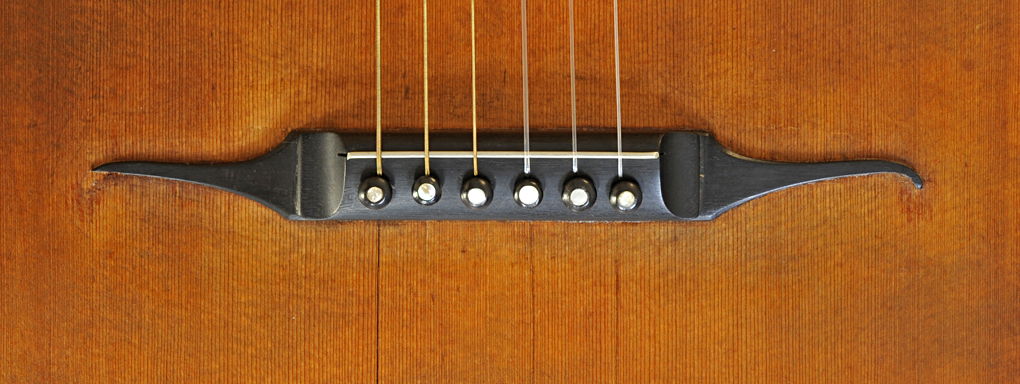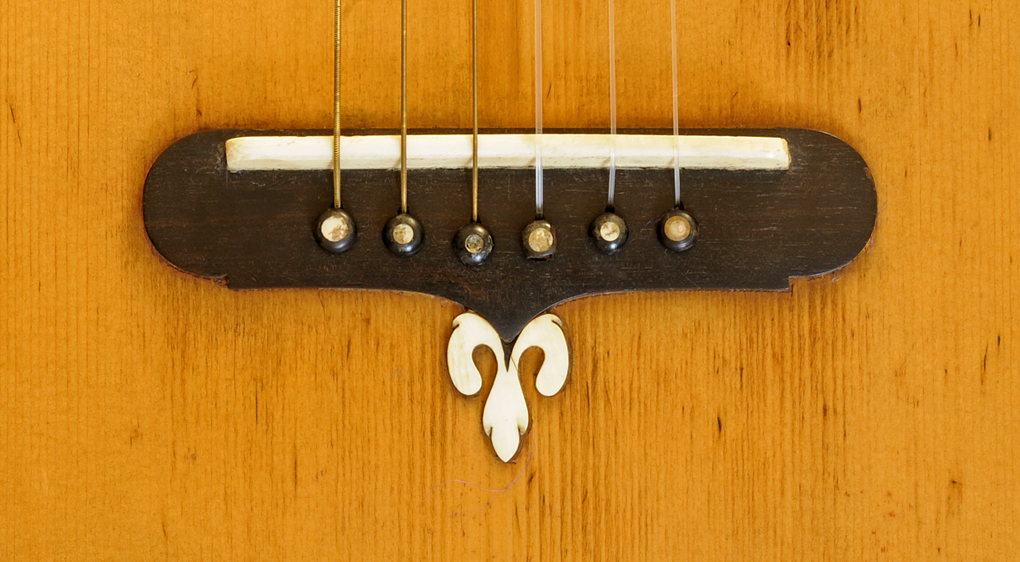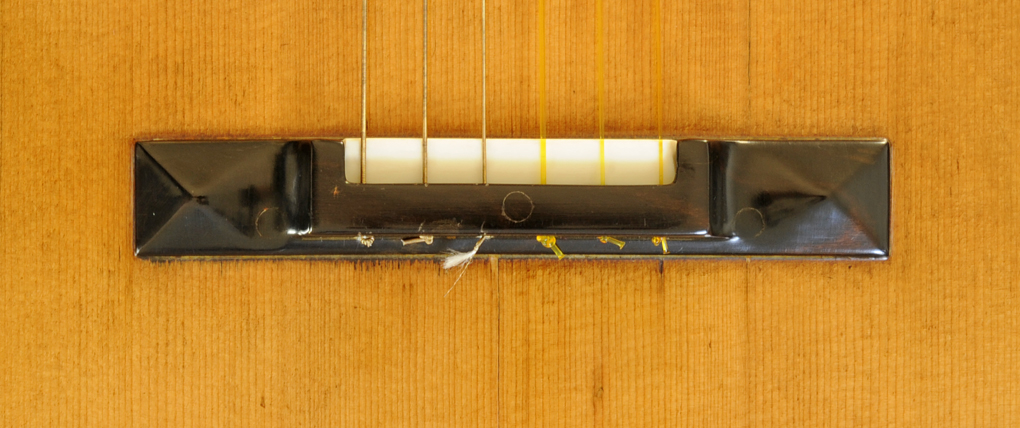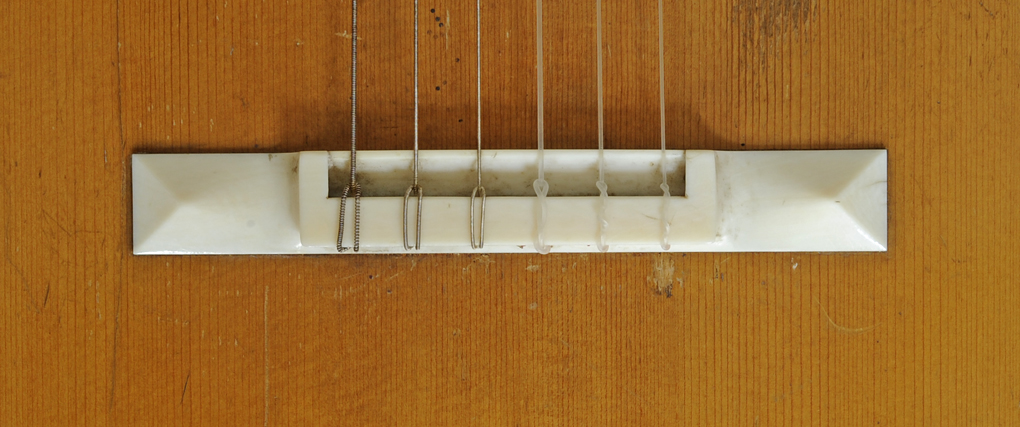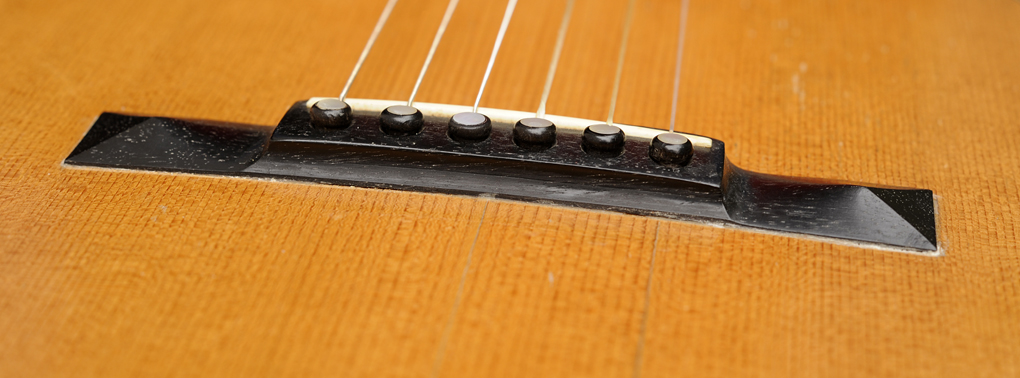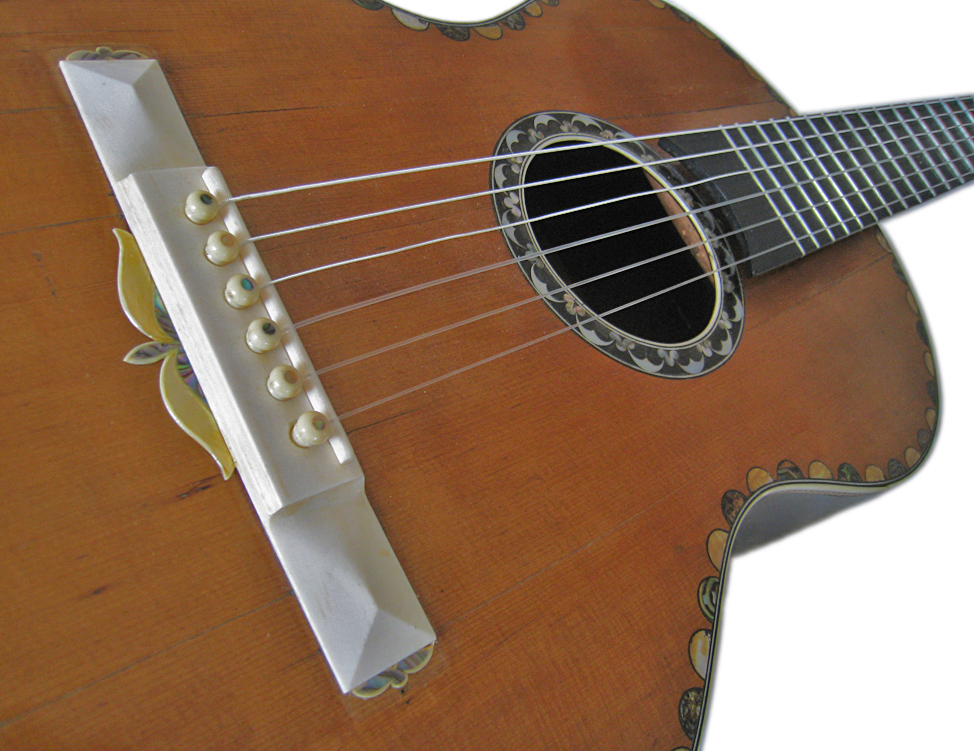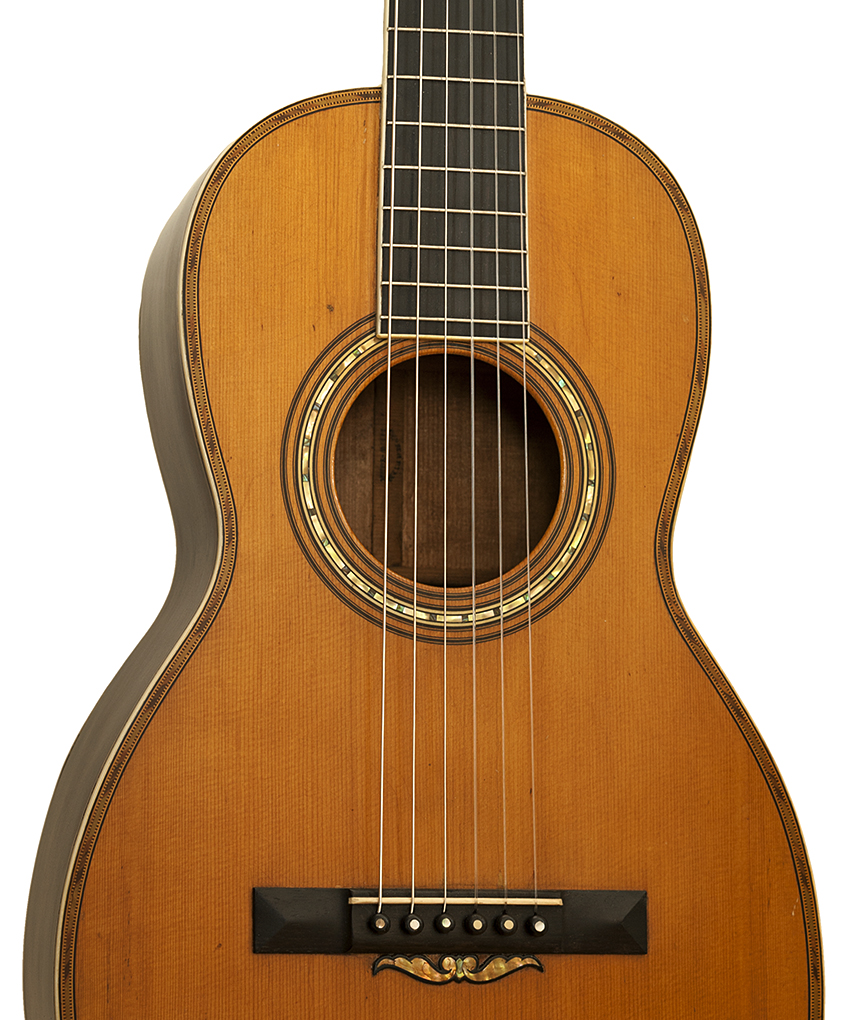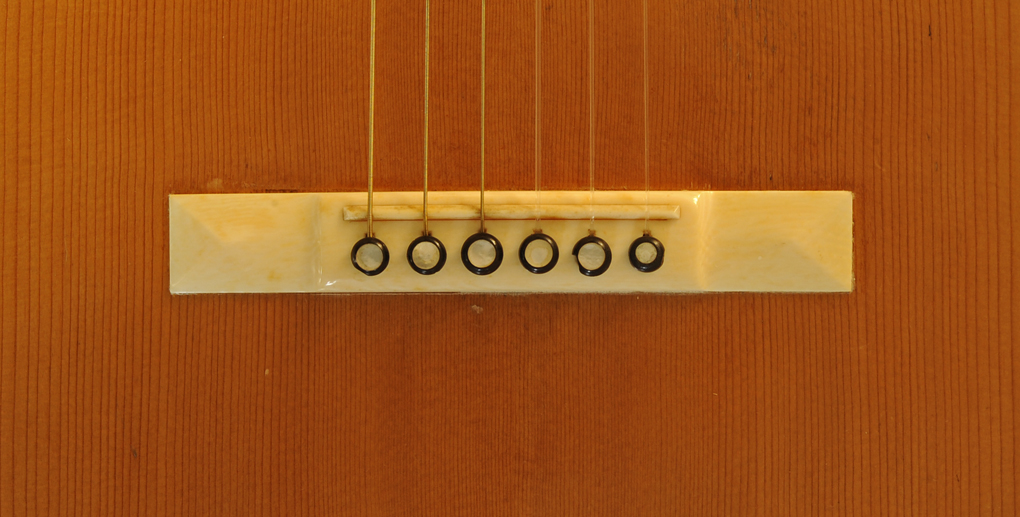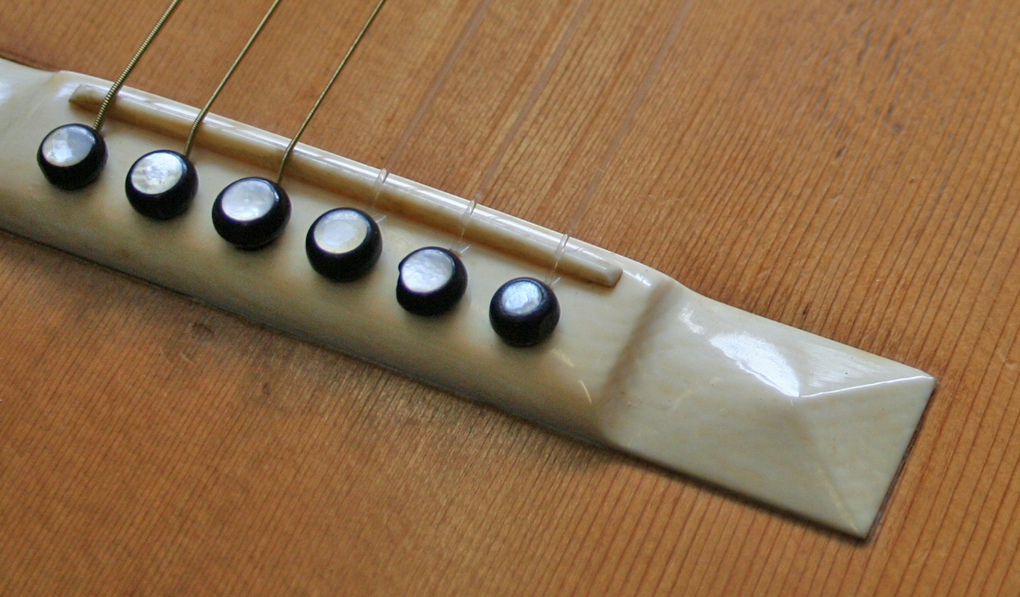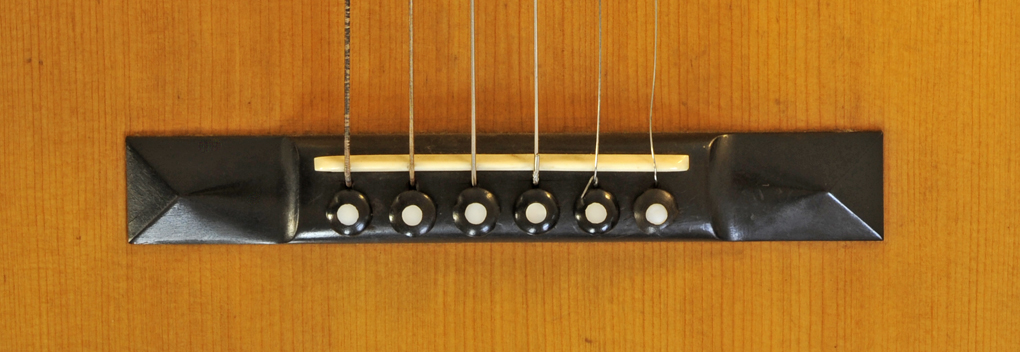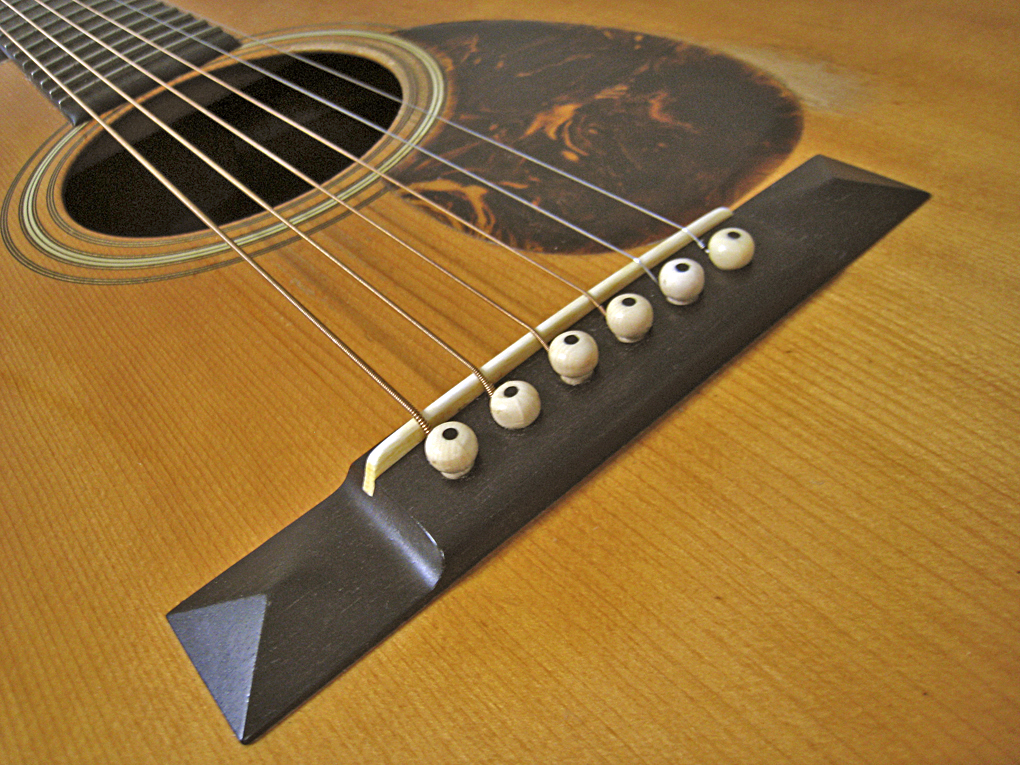THE BRIDGE TO SOMEWHERE
The Evolution of Bridges on Martin Guitars
C.F. Martin used many bridge designs on his guitars. Here we trace the evolution of bridges used by Martin and his descendants through the years.
The "moustache" bridge, with a fretwire saddle, appears on early Stauffer and Martin "Stauffer Style" guitars.
While the pin style bridge is generally associated with steel string guitars, pin style bridges were used on the gut string guitars of Stauffer as well as the earliest of Martin's guitars, produced close to 100 years before the introduction of Martin's steel string guitars.
A number of early Martin, Martin & Coupa, and Martin & Schatz guitars, such as this one, have the "badge" or "shield" style bridge, in either ebony or ivory, here seen with an added "flower" or pendant. Some ivory versions have a fretwire saddle similar to those on the Stauffer "moustache" bridges. Some have a simple "drop in" ivory saddle such as this.
This Martin & Coupa has an ebony version with an ivory pendant.
The ivory version may be the most beautiful and tasteful of all Martin bridges. The pendant on this example has an abalone inset. Some ivory examples have a fretwire saddle similar to those on the Stauffer "moustache" bridges.
Some have a simple "drop in" ivory saddle such as this one:
Many early Martin and Martin & Coupa guitars have a pyramid "tie" style bridge, such as those seen on early guitars from Spain.
Early versions, such as on this Martin & Coupa, are ebony with a wide ivory saddle which curves up to form a clean edge:
This Spanish style Martin, probably slightly later, has an ivory version of the tie style pyramid bridge, still with a wide curved ivory saddle.
The ivory tie style pyramid bridge is 25/32" x 5 29/32". The ebony tie style pyramid bridge above is a quite differently proportioned 29/32" x 1 27/32"
The earliest pin style pyramid bridge is only a slight step away from the "tie style" pyramid, with a similar "lipped" or "scooped" back, and the notched "drop in" saddles.
As you can see from this example, the early pyramid bridges were paper thin.
This scooped back ivory pin bridge on this very early Hudson Street Martin is likely a replacement, but the decorative ivory and pearl pendants are surely original from 1837. It's entirely possible, however, that this guitar did originally have a pyramid bridge.
The pendants are seen on Martins as late as the 1850's, as on this Martin with an interesting early pearl rosette:
The vestigal "lipped" or "scooped back", however, was only produced for a very short time.
I have an early spruce lined style 27 with the round back pyramid bridge. My early style 28 with checkerboard binding and early hybrid X-bracing has a pyramid bridge which is even longer than the style 34 mentioned above, but appears to be original, certainly very early, which has a round back as well. And the shark tooth rosette style 23 has a round back pyramid bridge as well.
I see that the lipped bridges I have are 27/32" x 5 27/32". Most of the early round back pyramids are 7/8" x 5 7/8".
My "sharks tooth" 23, with a 7/8" x 5 27/32" pyramid, might have been transitional.
I have style 24 Martins with both fan and X-bracing with the lipped or scooped back bridges.
I wonder if it might have only been used on certain style guitars.
While the measurements, such as the body width, of somewhat later Martins can vary considerably from one example to the next, the measurements of early Martins are extremely precise.
These are later round back pyramid bridges in ivory, which appear until about 1919 with a notched drop in saddle:
If you look carefully, in this photo you can see the center portion of the drop in saddle which fits into the bridge, while the a short portion of the saddle at either end fits over the bridge.
It is also clear from these photos that the saddle is parallel to the front edge of the bridge, with no compensation. The saddles are generally 1/8" from the front of the bridge.
This 2 1/2 - 17 is from 1889:
As you can see, many pyramid bridges made until just after the turn of the century were finished, and not bare wood.
Since Martin switched from a long saddle to a short saddle in 1965, most people assume that the long "through-cut" saddle pre-dated the short drop-in saddle. But as you can see, even earlier Martin bridges had short saddles before the long saddle appeared.
If you look carefully at the photograph of the ivory saddle above, you can see that the saddle is notched, with the exposed part of the saddle extending further than the shorter "drop-in" portion.
The new edition of Longworth, page 38, states that the notched saddles are "typical of pre-1910 Martins" while also saying "by the 1920's the saddle slot was open on both ends".
From what I've observed, by 1916 you start to see some saddles with a long visible top portion that extends to the ends, but that are still notched. The long through-cut saddles appear soon after.
The first of the through-cut saddles may have been on bridges purchased by Martin from Chicago in 1916.
Martin switched back to the short saddle in 1965.
The ebony pyramid bridge was used until 1930, though it has been revived for models such as the new version of the Ditson 111.
This pyramid bridge is on an early 1930 OM-28.
Notes:
a) Pyramid bridges should have a curved slope on the inside portion of the pyramid. Bad copies have four straight edges. The saddles were not slanted until ( ), and they were also drop in for 80 years until 1919. The through saddle didn't start until 1919 (1920?) and lasted until about 1968 when they went back to the drop-in style. I have seen a 1920 0-28 with a drop in saddle.
b) Size:
1. Size 1 and larger from all years have bridges 6" long
2. Size 2 and 2 1/2 Martins have bridges 5 7/8" to 5 3/4" long. At least until the 1890s.
I see that the lipped bridges I have are 27/32" x 5 27/32". Most of the early round back pyramids are 7/8" x 5 7/8".
PYRAMID BRIDGE LENGTH
The earliest pyramid bridges, at least going back to the 1850's, are 5 7/8" long.
From the mid 1890's through the 1930 OM, they are 6" long.
Some from the 1870's to the 1890's are 5 3/4" long.
PYRAMID BRIDGE WIDTH
Most before 1900 are roughly 7/8" wide. Some from the 1840s or 1850s are 13/16" wide.
Most after 1900 are 1" wide.
I have one from 1926 that is 15/16" wide.
PYRAMID BRIDGE WINGS
The average length of the wings on most pyramid bridges is roughly 1 3/8"
During the 1880's and 1890's, however, there is more variation, as much as from 1 1/4" to 1 1/2"
On the earlier 7/8" wide bridges, the wings have a very long, narrow, elegant appearance, with a gentle curve to the inside angles of the pyramids, that looks nothing at all like the harsh angles found on many of the bad copies.
I found no difference between the dimensions of ivory and ebony bridges from the same period.
It's interesting that the earlier years have more consistency in length than the middle years. Some time ago I did a survey of the body dimensions of my early guitars, and I found the earliest years to be precise, while the middle years had much more variation.
This 1885 0-34 bridge is the longest and narrowest of the lot, 6" long, 7/8" wide, with 1 1/2" long wings:
STRING SPACING
It appears that Martin was moving to 2 5/16" spacing on size 2 guitars, and 2 3/8" spacing on size 1.
(all listed are pre-1867 unless otherwise noted)
Original Stauffer - moustache bridge. 2 5/16"
Hudson Street - replacement ivory pin bridge. 2 5/16"
Early fancy Spanish size 3 - ivory tie bridge. 2 7/16"
Ivory fingerboard Stauffer headstock - replacement ebony pin bridge. (I've wondered if the original was ivory pin or tie). New bridge plate. 2 1/4"
Early Spanish Martin & Coupa - ebony tie bridge with ivory inset 2 9/32"
Koa Martin & Coupa - shield shape bridge, pins in arc. 2 5/16"
LIGHT DIAMOND BACKSTRIPS/ Spanish foot
Hybrid X 1-28 2 3/8"
LIGHT DIAMOND BACKSTRIPS/ split neck blocks, old marquetry end
2-23 2 1/4"
2-24 2 5/16"
2-24 2 5/16"
2-20 2 5/16
DARK DIAMOND BACKSTRIPS
2-23 2 5/16" (solid block)
2- 21 2 5/16" (split block)
2-20 with herringbone backstrip, old marquetry end 2 5/16
1-26 with zig zag marquetry border 2 3/8"
1-21 with zig zag marquetry rosette 2 5/16"
Early 1-28 with pearl rosette 2 7/16"
Early 2-27 2 5/16"
post '67 2-27 2 5/16"
1890's 2-42 2 5/16"
vintagemartin.com
To See Robert Corwin's Classic Photography of Folk and Roots Musicians, visit:
For Information on Photography for
Exhibition, Publication, CD's, Promotion, Web Pages, Tour Books,
to Purchase Photographic Prints, or
If You Have Questions or Suggestions About This Web Site or Vintage Martin Guitars:
e-mail: Robert Corwinentire site copyright ©1998 through 2015 Robert Corwin/Photo-Arts. All rights reserved.
